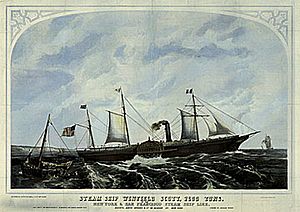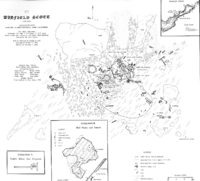SS Winfield Scott facts for kids
|
Winfield Scott color lithograph
|
|
| History | |
|---|---|
| Namesake | Winfield Scott |
| Operator | Pacific Mail Steamship Company |
| Route | Panama-San Francisco |
| Builder | Westervelt & MacKay |
| Launched | 27 October 1850 |
| Out of service | 2 December 1853 |
| Fate | Wrecked on Anacapa Island |
| Notes | Set a record 49-day transit between New York and San Francisco in 1852 |
| General characteristics | |
| Type | Passenger |
| Tonnage | 1,291 gross tons |
| Length | 225 feet (69 m) |
| Beam | 34.6 feet (10.5 m) |
| Depth | 29.1 feet (8.9 m) |
| Decks | 3 |
| Installed power | 2 × Morgan Iron Works side-lever steam engines |
| Propulsion | 2 × paddle-wheels assisted by sail |
| Sail plan | Three masts, square sails |
| Capacity |
|
|
SS Winfield Scott (Steamship)
|
|
| Location | Anacapa Island |
| Area | 0.7 acres (0.28 ha) |
| Architect | Westervelt & MacKay |
| NRHP reference No. | 87002111 |
| Added to NRHP | 12 September 1988 |
The SS Winfield Scott was a large steamboat that used paddle wheels to move. It carried people and goods between San Francisco, California and Panama in the early 1850s. This was a very busy time because of the California Gold Rush.
On December 1, 1853, the ship sailed into a thick fog near Southern California. It then crashed into Anacapa Island. Luckily, all 450 passengers and crew members survived, but the ship was lost. Today, the Winfield Scott lies underwater. It is part of the Channel Islands National Park and Channel Islands National Marine Sanctuary. The shipwreck site is also listed on the National Register of Historic Places.
Contents
The California Gold Rush and Travel
The discovery of gold in California in 1848 changed everything. Thousands of people rushed to the state, hoping to find their fortune. This period lasted until the late 1850s. Back then, traveling from the Eastern United States to California was very hard. There were no easy ways to get there.
People had three main choices for travel. They could go by land, which was costly and dangerous. Or, they could sail about 14,000 miles around South America. This route was also risky, especially because of the rough waters near Drake Passage. Both of these journeys often took as long as six months.
The third option was to cross the jungles of Panama. Then, travelers would catch another ship from Panama's southern coast. This cut the sea journey in half. However, there weren't many ships available to take passengers from Panama to San Francisco. This meant many people had to wait months to finish their trip. To meet this growing need, many new ships were built.
Building and Journeys of the Ship
The Winfield Scott was built by Westervelt and MacKay in New York. It was finished in March 1850. The ship was first going to be named Placer. It was named after a famous U.S. Army general, Winfield Scott. A sculpture of his head was even placed on the back of the ship. The ship was launched on October 27, 1850.
Newspaper reports at the time said that "no expense had been spared" to make the ship strong, safe, and fast. Its hull was made of wood with strong iron supports. It used different types of tough wood like White oak and Live oak.
The Winfield Scott first carried passengers between New York and New Orleans. In 1852, a new company, the New York and San Francisco Steamship Company Line, bought the ship. It arrived in San Francisco on April 28, 1852. From then on, it started taking gold seekers, also called "argonauts," on the Panama Route. This route went between San Francisco and Panama. In July 1853, the ship was sold again to the Pacific Mail Steamship Company.
The Ship's Final Trip
The Winfield Scott left San Francisco on the morning of December 1, 1853. It was heading for Panama. Besides its passengers and crew, the ship was carrying a lot of gold bullion. This gold was worth about US$2 million, which was a huge amount of money back then.
The ship slowed down in the afternoon because of a leaking boiler. But after repairs, it continued at full speed. Later that night, Captain Simon F. Blunt decided to sail through the Santa Barbara Channel. He knew this area well from surveying it before. He hoped this would save time.
Around 11 PM, a very thick fog appeared. The ship then crashed into Middle Anacapa Island, about 400 miles from its starting port. The ship hit the island front-first. When Captain Blunt tried to back away, the back of the ship also hit, and its rudder broke off. The ship began to fill with water and could not steer. Everyone on board, possibly as many as 500 people, rushed to get to land.
All passengers and crew got off the ship in about two hours. They spent the first night on a small rock area, about 50 by 25 yards. The next day, they moved to a larger part of the island. One passenger, Asa Cyrus Call, remembered "a terrible jar and crashing of timbers." He saw "a wall of towering cliffs" hidden by fog and darkness.
On December 2, another steamship, the SS California, was heading back to San Francisco. It saw smoke from a gun fired by the shipwreck survivors. The California rescued the women and children first. It also saved the Winfield Scott's valuable gold. On December 9, the California returned for the rest of the passengers. The crew stayed behind to try and save mail and luggage. But the Winfield Scott was too damaged and was left in the water.
The Shipwreck Today
The remains of the Winfield Scott lie under 25 to 30 feet of water. They are located within the Channel Islands National Park and Channel Islands National Marine Sanctuary. The shipwreck site was confirmed in 1981. It was added to the National Register of Historic Places in 1988. It is against the law for divers to remove any part of the wreckage.
People have tried to salvage parts of the ship over the years. In 1894, a salvage operation recovered much of the iron machinery and many copper bolts. During World War II, another operation took more iron and brass to help with the war effort.
Even though much of the wooden hull is gone, some of the machinery is still in good shape. The remaining wreckage is very important for understanding how ships were built in the mid-1800s.
The waters around the Channel Islands National Park Marine Sanctuary can be dangerous for ships. Between 1853 and 1980, over 140 shipwrecks happened there. By December 2000, twenty of these sites had been found.
What We Learned
The wreck of the Winfield Scott showed how dangerous sailing could be. Soon after the crash, the U.S. National Geodetic Survey suggested building a permanent lighthouse on Anacapa Island. Because of a lack of money, a simple, unmanned light tower wasn't built until 1912. This tower was later replaced by a full lighthouse in 1932.




